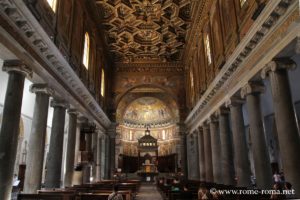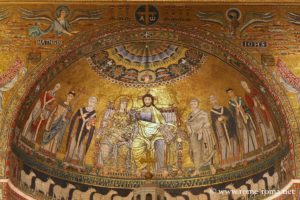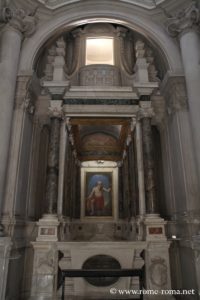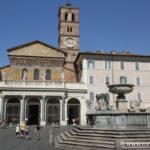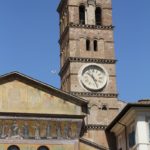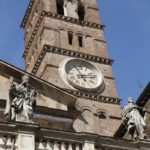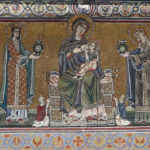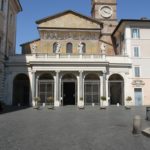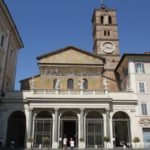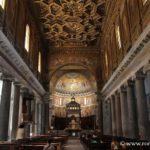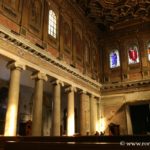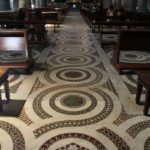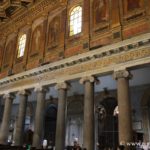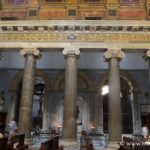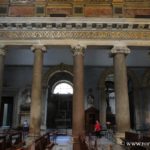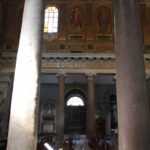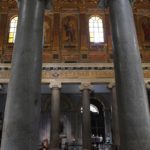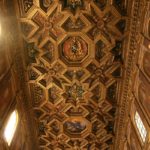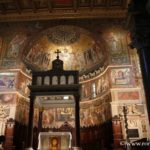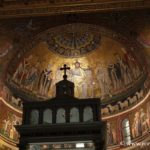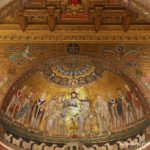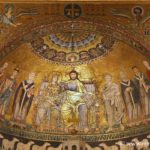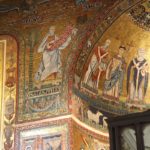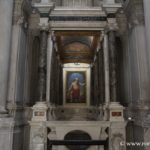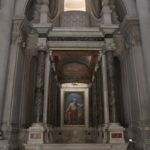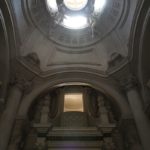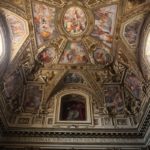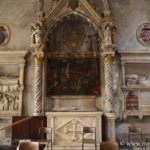The beautiful church of Santa Maria in Trastevere has been the heart of the Trastevere district for over a thousand years.
Located on the square that bears its name, the present building, dating back to the 12th century, has preserved the charm of its medieval Romanesque character, embellished with splendid mosaics.
Its foundations rest on the ruins of a 3rd-century Christian building, one of the earliest house churches in Rome, known as the Titulus Callisti.
Brief history of the basilica
A legend reported by Eusebius of Caesarea tells that a spring of oil gushed forth here in 38 BC, announcing to the Jews of the district the coming of the Messiah. Another story recounts that Pope Calixtus I (217–222) established a Christian community in a tavern, which took the name of Titulus Callisti.
In 340 AD, Pope Julius I built a larger building, then called Titulus Iulii, the center of one of the first twenty-five parishes of Rome. It is said to have been the second church dedicated to the Virgin, in the 5th century, the first being the Basilica of St. Mary Major.
In the 8th and 9th centuries, it was enlarged with side aisles, then Gregory IV remodeled the choir, added the chancel, ciborium, and a crypt that housed the relics of Calixtus I.
The church was rebuilt between 1140 and 1143 by Pope Innocent II, adding a transept, the apse mosaics, and architectural elements (such as Ionic capitals on the nave columns) that were taken from the Baths of Caracalla and the Temple of Isis on the Janiculum hill.
Visit, architecture and artworks
Exterior: façade, bell tower and atrium
The pediment of the façade bears a 13th-century mosaic frieze of the Virgin nursing, between ten women holding lamps, a symbol of virginity.
At the top of the charming 12th-century Romanesque bell tower, a niche houses a mosaic of the Virgin and Child.
The portico was rebuilt in the early 18th century by Carlo Fontana during the restoration of the façade. On its balustrade stand the statues of Popes Calixtus I (†222), Cornelius (†253), Julius I (†352), and the martyr Saint Calepodius (†232). The interior of the portico preserves Christian frescoes and fragments of 3rd-century AD sarcophagi.
Under the Atrium are preserved numerous marbles and Christian and pagan epigraphs, originating from the catacombs and the early Christian basilica, such as simple prayers, symbols engraved by the first Christians, or true poems such as the ex-voto of Crescenzio.
There are also mosaics from different periods, sarcophagi from the 4th century, the 12th century, etc.
The Romanesque interior, which has retained the plan of the original basilica, is formed by three naves separated by two rows of 11 Ionic and Corinthian columns. Their ancient capitals come from the Baths of Caracalla. The Cosmatesque pavement, restored by Vespignani in the 19th century, was installed by the Cosmati in the 12th–13th centuries.
Domenichino created the beautiful wooden coffered ceiling around 1617, with an Assumption of the Virgin at its center.
The choir mosaics, in a style of Byzantine influence, are considered the masterpiece of the church. They illustrate scenes from the Gospel.
In the center of the apse, Christ and the Virgin are seated on a throne, flanked to the left by Saints Calixtus, Lawrence, and Innocent II carrying a model of the church. On the right are Saint Peter, Pope Cornelius, Pope Julius I, and Saint Calepodius. Mary is embraced by Jesus (as a sign of his love and protection, a role entrusted to his church). Above, the hand of God blesses and crowns the Son (as the victor over death and sin).
Below, two rows of lambs come out of Bethlehem and Jerusalem to join Christ.
The mosaics of the lower register were created by Pietro Cavallini in 1291. They narrate in a very fine style scenes from the life of the Virgin. Their style differs from the earlier mosaics by introducing perspective effects, a novelty at the time. Depicted around the Coronation of the Virgin are the Annunciation, the Nativity of Jesus, the Adoration of the Magi, and the Presentation of Jesus in the Temple.
On the triumphal arch, the 12th-century mosaics evoke the Apocalypse. They depict the prophets Isaiah and Jeremiah, the symbols of the four Evangelists, and the candlesticks of the seven churches mentioned in the Apocalypse. At the center is the cross with the Alpha and Omega (Jesus being the first and last letter of our life).
In front of the choir, the marble candelabrum marks the site of the oil spring said to have gushed forth on the day of Christ’s birth.
Chapels and relics
The first chapel on the left aisle is the Chapel of Saint Jerome (Cappella San Girolamo), belonging to the Avila family, with Baroque stuccoes by Antonio Gherardi from 1680, who gave it an original layout influenced by Borromini’s style. An elaborate perspective was sculpted above the altar, lit by a window from the inside.
In its dome, the lantern is surrounded by four flying angels carrying a small round temple with the dove of the Holy Spirit. The painting, also by Gherardi, depicts Saint Jerome, and at his feet the tomb of Pietro and Giacomo Avila.
Between the third and fourth chapels, the tomb of Innocent II is a work by the architect Vespignani, who restored the church between 1866 and 1877.
In the Altemps Chapel, the frescoes were painted in 1589 by Pasquale Cati. The altar houses the precious icon of the Madonna della Clemenza, dated between the 6th and 8th centuries. It is believed to be the oldest wooden representation of the Virgin.
The basilica also houses the relics of Pope Julius I, as well as the remains of Popes Calixtus I and Innocent II.
Map and address
Address : Piazza di Santa Maria in Trastevere, 00153 Roma RM, ItalieIf you see this after your page is loaded completely, leafletJS files are missing.
Information
| Basilica of Santa Maria in Trastevere Piazza di Santa Maria in Trastevere, 00153 Rome |
| Opening Hours Hours every day except in August: 7:30 AM – 9:00 PM, Fridays: 9:00 AM – 9:00 PM, Saturdays and Sundays: 7:30 AM – 8:00 PM In August, opening hours: 8:00 AM – 1:00 PM / 3:30 PM – 9:00 PM |
Sources and Links for More Information |
Photo gallery
Exterior and Square
- Santa Maria in Trastevere Square
- Santa Maria in Trastevere Square
- XII AC Bell tower
- XII AC Bell tower
- Pediment with 13th-century mosaic and 17th-century statues
- Pediment with 13th-century mosaic and 17th-century statues
- Mosaic frieze of the thirteenth
- Fountain Piazza Santa Maria in Trastevere
- Piazza Santa Maria in Trastevere
- Piazza Santa Maria in Trastevere
Interior
- Nave and columns
- Nave and columns
- Cosmatesque ground
- Nave and columns
- Nave and columns
- Nave and columns
- Nave and columns
- Nave and columns
- Apse and canopy
- Coffered ceiling
- Apse and canopy
- Apse and canopy
- Apse mosaic (XIII aC)
- Apse mosaic (XIII aC)
- Abside
Chapels and Works
- Chapel Saint Jerome (XVII aC)
- Chapel Saint Jerome (XVII aC)
- Chapel Saint Jerome (XVII aC)
- Altemps Chapel
- Madonna della Clemenza
- Monuments to Philippe d’Alençon and Pietro Stefaneschi
Articles around the square
- Basilica of Our Lady in Trastevere
 Santa Maria in Trastevere was built in the 12th century. Discovery of the church: visit and schedule, description of the ...
Santa Maria in Trastevere was built in the 12th century. Discovery of the church: visit and schedule, description of the ...


